#Nasiruddin Shah
Text
Mouni Roy Opens Up About Similarities With Her Character In Showtime
Nepotism ke mukhaute ke picche, akhir mein har outsider, insider banna chahta hai. Disney+ Hotstar and Dharmatic Entertainment unveil the trailer of their much awaited series, Showtime. The money, the business, the glamour, the relationships, the lifestyle, the inside scoop on all of Bollywood’s best-kept secrets, Showtime is releasing exclusively on 8th March on Disney+ Hotstar. Showtime is…

View On WordPress
#Dharmatic Production#Disney Hotstar#Disney+#Emraan Hashmi#Hotstar#Karan Johar#Mouni Roy#Mouni Roy Opens Up About Similarities With Her Character In Showtime#Mouni Roy Showtime#Nasiruddin Shah#Showtime
2 notes
·
View notes
Text
Book of Delicacies
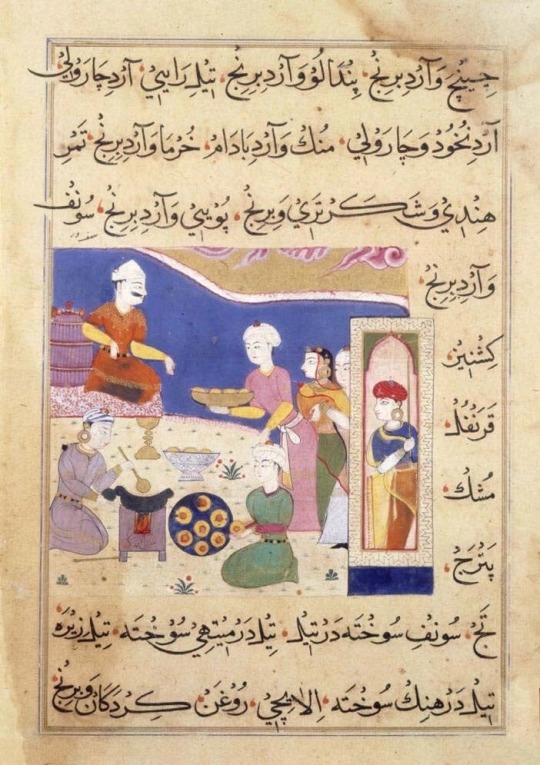
Historical Resource: *Ni’matnama-i-Nasiruddin-Shahi* or Book of Delicacies is a medieval Indian book from c.1500 featuring recipes of delicacies as well as illustrations of food preparation. The Naksh script used in this manuscript is from Farsi (Persian language). The image is a page from the manuscript showing Samosas (a savoury pastry fried in ghee or oil, stuffed with either spiced vegetables or meat) being served.
“Sultan of Mandu, Ghiyath Shahi seated on a stool in a garden is being offered a dish of samosas. A cook is frying them over a stove, while another is placing them on a round dish. Opaque watercolour. Sultanate style. Title of Work: The Ni'matnama-i Nasir al-Din Shah. A manuscript on Indian cookery and the preparation of sweetmeats, spices etc. 1495-1505" (The British Library)
0 notes
Text
List of founder, best ruler, and last rulers of all the dynasties of the Delhi Sultanate:
Table of the founder, best ruler, and last rulers of all the dynasties of the Delhi Sultanate:
DynastyFounderBest rulerLast rulerMamluk dynastyQutbuddin Aibak (1206-1210)Iltutmish (1211-1236)Nasiruddin Mahmud (1246-1265)Khalji dynastyJalaluddin Khilji (1290-1296)Alauddin Khilji (1296-1316)Mubarak Shah (1320)Tughlaq dynastyGhiyasuddin Tughlaq (1320-1325)Muhammad bin Tughlaq (1325-1351)Firuz Shah Tughlaq (1351-1388)Sayyid dynastyKhizr Khan (1414-1421)Mubarak Shah (1421-1434)Alauddin Alam Shah (1443-1451)Lodi dynastyBahlul Khan Lodi (1451-1489)Sikandar Lodi (1489-1517)Ibrahim Lodi (1517-1526)
The best ruler of the Delhi Sultanate is considered to be Alauddin Khilji of the Khalji dynasty. He was a strong and capable ruler who expanded the Sultanate's territory and made significant reforms to its administration. He is also known for his ruthlessness and his use of terror to maintain control.
The Delhi Sultanate was founded by Qutbuddin Aibak, a slave of the Ghurid ruler Muhammad Ghori. The Sultanate lasted for over 300 years and was ruled by five different dynasties. It was eventually overthrown by the Mughals in 1526.
Read the full article
0 notes
Text
Untuk Masjid Hopping bulan Ramadhan ini, saya sudah berkunjung ke empat pusat solat untuk lima malam. Jadi ini review saya:
PISAF: panas dengan tiada pengudaraan. Orang yang ramai buat tempat ini jadi lagi sesak dan cepat berpeluh. Tapi pro nya adalah imam daripada kalangan kami yang faham yang kami bukan suka sangat untuk solat lama lama. Kebanyakannya juga punya bacaan yang sedap.
Masjid Limbongan: ruang yang agak selesa dengan karpet yang tebal. Bacaan imam yang laju walaupun panjang dengan satu muka setiap rakaat. Saya ok sahaja sebenarnya. Yang buat saya tidak selesa adalah kerana budak budak yang bermain dalam saf dan bising betul betul di hadapan saya. Buat saya rasa marah dan terganggu khusyuk dalam solat.
Masjid Ibu Abbas: satu kelainan di sini. Walaupun tidaklah sejuk mana, tetapi ia punya pengudaraan yang bagus yang jadikan ia tidak terlalu panas. Bacaan imam yang laju dan tidak terlalu panjang tetapi dalam masa yang sama sedap. Yang berikan kelainan adalah bacaan hadis di antara rakaat ke 4 dan ke 5. Saya agak terkejut dan kagum. Ini kali pertama saya berkunjung ke masjid yang sebegini. Ia bagi masa untuk jemaah rehat sebentar dengan pengisian yang bermanfaat.
Masjid Nasiruddin Shah: saya rasa ini masjid yang menawarkan semua yang seorang makmum inginkan. Bacaan imam yang sedap dan pendek dengan separuh muka satu rakaat. Karpet yang sangat tebal, aircon yang ditala ke tahap maksimum dan lambakan kipas yang buatkan makmum selesa untuk solat. Kalau ada yang kurang, mungkin kerana ia terletak sedikit di tengah pekan dan ruang parkir yang sesak. Tidak hairanlah dengan kelebihan yang ia tawarkan.
Untuk hari hari berikutnya, jika diberi kesempatan, akan saya teruskan sesi masjid hopping ini.
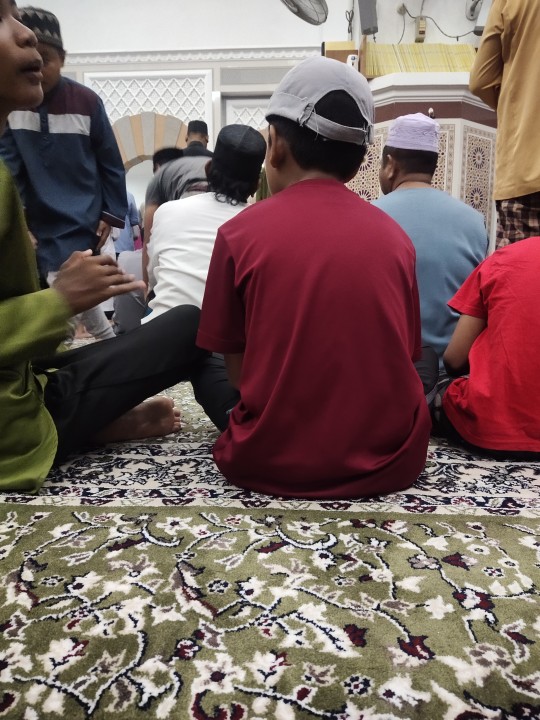

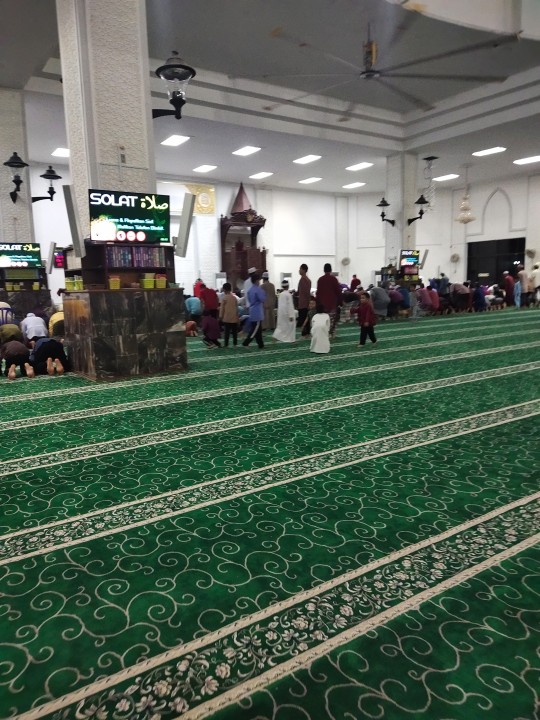
0 notes
Text
Have you ever wanted to unlock the secrets of দোয়া কুনুত? Is it a mysterious and unknown language to you?
Well, you are in the right place. দোয়া কুনুত is an ancient Bengali script that has been used for centuries by many prominent figures and rulers in Bengal. It is a beautiful language full of secrets that can be unlocked if you have the right resources and knowledge.
In this article, we will explore দোয়া কুনুত in detail and provide a step-by-step approach to understanding it. We will delve into its origins, its writing system, and its popular uses. You'll also learn how to read, write, and even speak it with confidence! So let's get started on this thrilling journey!
Introduction to দোয়া কুনুত
দোয়া কুনুত, or double cleansing, is an ancient skincare practice that has recently come back into focus. Originating in South Asia, the practice is based on the idea that cleansing your skin in two stages can help it better absorb treatment products and leave it feeling cleaner and healthier.
The process itself is quite simple--first, you use an oil-based cleanser to remove dirt, oil, makeup and sunscreen from your skin. Following this, you wash with a gentle water-based cleanser to unblock pores and treat any skin concerns.
Around the world, many people have now begun to incorporate দোয়
Origins of দোয়া কুনুত in Bengal
দোয়া কুনুত has been a part of the fabric of Bengali culture for centuries. Its origins can be traced back to ancient Hindu texts, such as the Mahabharata and the Ramayana, which both make mention of this beloved activity. The popularity of দোয়া কুনুত spread through the Indian subcontinent, eventually reaching Bengal in the 13th century CE.
The rules and regulations governing দোয়া কুনুত have evolved over time, with changes to its structure and playing style brought about by different rulers. By 1498 CE, it had become codified into its current form by Sultan Nasiruddin Mahmud Shah. The popularity of the game continued to grow and it became an important part of Bengali culture, with even its symbols being used as motifs in paintings and other forms of art.
In modern times, দো
Health Benefits of Eating দোয়া কুনুত
Did you know that দোয়া কুনুত is actually very healthy? Yep, it's true! Eating দোয়া কুনুত on a regular basis can help to improve your overall health and well-being. Here's a look at some of the health benefits:
High in Protein
Protein is essential for our bodies—it helps to build and repair muscles, aids in digestion and even makes hormones. দো
The Different Types of দোয
Did you know that দোয়া কুনুত can be written in many different forms? As many as three distinct forms, in fact!
These three forms, sometimes referred to as subgenres of দোয়া কুনুত are:
Chiti: the most common form of Bengali poetry, composed of four lines and typically written in rhyming couplets
Ekti: a longer form of Bengali poetry, usually composed with five or more lines and typically written in blank verse
Kobita: a type of poetic prose often composed with two or more stanzas, meant to be read aloud dramatically
Whatever type of দোয় you choose to write, you can be sure it will always captivate your audience. That's because Bengali is such a beautiful language and the combination of words creates stunning imagery that captures the attention of anyone who hears it.
Conclusion
দোয়া কুনুত এর আসল ভৌতিক রূপকে একবার আমরা আগে থেকেই জানি। এটি আমাদের অনেকটি অবদান দিতে পারে তবে, এটির
0 notes
Text
"Shah Shuja, who had been governing Bengal, immediately proclaimed emperor[, s]triking coins and having the khutba read in the proud new name he had chosen, Abdul Fauz Nasiruddin Mohammad, Timur III, Alexander II, Shah Shuja Bahadur Ghazi"
bro...
1 note
·
View note
Photo

Thanks for the kind words! ★★★★★ "Just wow." Shah Nasiruddin #etsy #floral #yes #no #banarasi #banarasisilksaree #banarasisaree #banarasiinusa #banarsisilksaree #georgettebanarasi https://etsy.me/3hEbzP8 https://www.instagram.com/p/CmPLj8nPdvS/?igshid=NGJjMDIxMWI=
#etsy#floral#yes#no#banarasi#banarasisilksaree#banarasisaree#banarasiinusa#banarsisilksaree#georgettebanarasi
0 notes
Text
Kuttey Movie Starcast Release date Story Review

Kuttey Movie Starcast Release date Story Review
Kuttey Movie Story Review – You should read movie reviews before watching a film if you want to know what to expect Especially if you don’t enjoy going to the movies all that much, it’s difficult to decide which movies are worth your time A review of the movie gives you a taste of what to expect from the film.
Let’s find out about the stars, directors, producers, and other details of the movie. You can find detailed information about Kuttey Movie release date, cast, plot, and more right here.
Title
Kuttey Movie
Type
Action , Crime
Produced By
Luv Ranjan, Rekha Bhardwaj, Ankur Garg
Directed By
Vishal Bharadwaj
Release Date
13 Jan 2022
Platform
--
Story
Aasman Bharadwaj
Production House
T-Series Films, Vishal Bhardwaj Pictures Pvt Ltd
Kuttey Star Cast
Arjun Kapoor , Taboo , Nasiruddin Shah,Konkana Sen,Radhika Madan,Shardul Bharadwaj
Kuttey Movie Story
Initially announced in August 2021, Kutte Movie is an upcoming action crime that will premiere in 2022.
This movie's poster depicted all the stars wearing dog masks.It is possible to see people wearing dog masks doing either police work or committing crimes here.
The tagline of the movie is na ye bhokte hai , na ye kaatte hai , bas sirf gurrate hai…………
Kuttey Movie Trailer
https://youtu.be/B3gQ31_Kbvs
Disclaimer:
You should not download Movies from illegal sites since Movie production companies spend so much time and money on producing each Movie. According to Indian law, piracy is a crime, and we never support it.
Read the full article
#kuttey2022releasedate#kutteymoviecast#kutteymoviereleasedate#kutteytrailer#kutteyupcomingmovie#upcomingmovies
0 notes
Text
Chalte chalte mera saaya
kabhi kabhi yun karta hai
Zameen se utth ke
saamne aa kar
haath pakad kar kehta hai
Ab ki baar main aage aage chalta hun
aur tu mera peecha karke
dekh zara kya hota hai.
(Sometimes, walking along,
my shadow leaves the ground,
stands facing me,
takes my hand and says
this time I’ll walk ahead,
and you follow behind)
- Gulzar
10 notes
·
View notes
Text

'This is a Sin!'
#meme#nasiruddin shah#bollywood#shah#nasir#gunah#urdu#hindi#sin#library#studies#exams#before exams#friend
4 notes
·
View notes
Text
ये लोग बिना दिमाग के आदमी हैं... भारत में तालिबान के हमदर्द मुसलमानों पर बोले केरल के गवर्नर आरिफ मोहम्मद खान
ये लोग बिना दिमाग के आदमी हैं… भारत में तालिबान के हमदर्द मुसलमानों पर बोले केरल के गवर्नर आरिफ मोहम्मद खान
नई दिल्लीकेरल के राज्यपाल और जाने-माने स्कॉलर आरिफ मोहम्मद खान ने तालिबान की शान में कसीदे पढ़ने वाले कुछ भारतीय मुसलमानों पर तीखा हमला बोला है। सीएनएन-न्यूज18 के साथ बातचीत में खान ने कहा कि ये लोग बिना दिमाग के आदमी है, जो रुढ़ीवादी भी कहे जाने के लायक नहीं हैं। उन्होंने कहा कि भारतीय मुस्लिमों के एक तबके की बातों से वह शर्मिंदा महसूस कर रहे हैं।
‘मैं लज्जित महसूस कर रहा’आरिफ मोहम्मद खान ने…
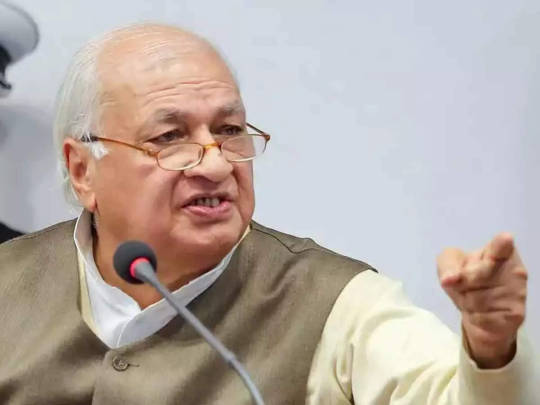
View On WordPress
#Afghanistan Taliban News#arif mohammad khan on devband#arif mohammad khan on taliban sympathizer#Arif Mohammed Khan On Taliban#india Headlines#india News#india News in Hindi#indian muslim clerics praise taliban#Latest india News#nasiruddin shah#section of indian muslims praising taliban#taliban rule in afghanistan#तालिबान के मुरीदों पर भड़के आरिफ मोहम्मद खान#भारत Samachar#मुस्लिम पर्सनल लॉ बोर्ड ने किया तालिबान का समर्थन
0 notes
Text

چلے لاکھ چال دنیا ہو زمانہ لاکھ دشمن
جو تری پناہ میں ہو اسے کیا کسی سے ڈرنا
chale laakh chaal duniya ho zamana laakh dushman
jo tiri panah mein ho use kya kisi se Darna
. Peer Nasiruddin Shah Naseer
#iam-usman#poetry#urdu poetry#urdu#urdu literature#repost#urdu adab#tumblr#promote urdu#urdu shayari#hindi shayari#best urdu poetry#peer nasiruddin shah naseer
10 notes
·
View notes
Text
The Slave Dynasty: 1206-1290 AD
The Slave Dynasty: 1206-1290 AD
The empire which ruled North India from AD 1206 to AD 1526 was known as the Delhi Sultanate because Delhi was their capital (the seat of their empire) and the kings were known as Sultans. Five successive dynasties ruled Delhi. These were the Slave Dynasty, Khilji Dynasty, Tughlaq Dynasty, Sayyid Dynasty and Lodi Dynasty.
The Slave Dynasty (1206-1290 AD)
Qutb-ud-din Aibak (1206-1210)
After…
View On WordPress
#Bahram Shah#Ghiyasuddin Balban#Iltutmish#Kaiqubad#Masud Shah#Nasiruddin Mahamud#Qutb-ud-din Aibak#Razia Sultan#Rúknuddin#slave dynasty pdf#slave dynasty upsc#slave dynasty was established in the year#The Slave Dynasty#who was the most powerful ruler of the slave dynasty#why did the slave dynasty decline#why is iltutmish called the actual founder of the slave dynasty
1 note
·
View note
Text
Berlin 1936: Know the Journey of Indian Field Hockey Team
#SportsCrunch: #DidYouKnow How invincible the #IndianHockey Team was at #Berlin1936? #1936SummerGames #DhyanChand #RoopSingh #AliDara #RichardAllen
Today we bring you the journey of Indian Hockey Team in Berlin 1936 Summer Games. Berlin 1936 was the eleventh edition of the Modern Olympic Games which started at Athens in 1896. The Olympic Games were hosted at Berlin, Germany. The Indian Team was led by Dhyan Chand and Jagannath was the Manager of this team. India successfully defended their Olympic title and gold medal that they won in 1932.…

View On WordPress
#Ahmed Sher Khan#Ahsan Mohammed Khan#Ali Iqtidar Shah Dara#Babu Narsoo Nimal#Berlin 1936#Carlyle Tapsell#Cyril Mitchie#Dhyan Chand#Ernest Goodsir-Cullen#Gurcharan Singh Garewal#Indian Hockey#Indian Olympians#Joseph Galibardy#Joseph Philips#Lionel Emmett#Mirza Nasiruddin Masud#Mohammed Hussain#Olympic Games#Peter Fernandes#Richard Allen#Roop Singh#Shabban Shahabuddin#Syed Mohammed Jafar
0 notes
Text
फिल्म इंडस्ट्री के बड़े-बड़े धुरंधर किसान आंदोलन पर चुप हैं: नसीरुद्दीन शाह
फिल्म इंडस्ट्री के बड़े-बड़े धुरंधर किसान आंदोलन पर चुप हैं: नसीरुद्दीन शाह
(नसीरुद्दीन शाह। भारत के जीवित कलाकारों में सबसे बड़ा नाम। इनकी समझदारी भरी संवेदनशीलता हमें अक्सर रास्ता दिखाती आई है। पिछले कई दिनों से नसीर साहब अपने बयानों को लेकर काफी चर्चा में रहे हैं। उनसे बात की जमील गुलरेज ने। प्रस्तुत है पूरी बातचीत : संपादक) प्रश्न: लॉकडाउन कैसा गुजरा?नसीरुद्दीन शाह: सच्ची मुझे बहुत ज्यादा परेशानी इसलिए नहीं हुई क्योंकि मुझे घर पर रहने की आदत है। मैं फिल्में करता हूं,…

View On WordPress
0 notes
Text
I’ve been trying to wean off of overdosage of Napoleonic warfare and fandom, so I could go for a fresh start upon a new subject. I decided that I’d go for something related to my Muslim heritage and relevant to me as a woman, since I really love the idea of women soaring through the male dominated world. So here it is!!
Razia Sultan: The First and Last Woman Muslim Ruler of the Indian Subcontinent
Sultan Raziyyat-Ud-Dunya Wa Ud-Din, or also referred to as Razia Sultan was known as the first and last female Muslim Ruler of the Delhi Sultanate. She was born in 1205 into the household of Shams-us-din Iltutmish, a Mameluke Sultan, and a former slave under Qutb-ud-din, who had risen to the post of a provincial governor in Delhi. Turkan Khatun was her mother.
Razia was not like most women. Razia grew up under the influence of leading a man’s life out in the world, instead of being shut away into harems and living behind the purdah, the separation of women from men using rooms or curtains.
Unlike most Sultans, her father ensured great qualities in all his children, including Razia. Razia trained in archery, martial arts, and administration.
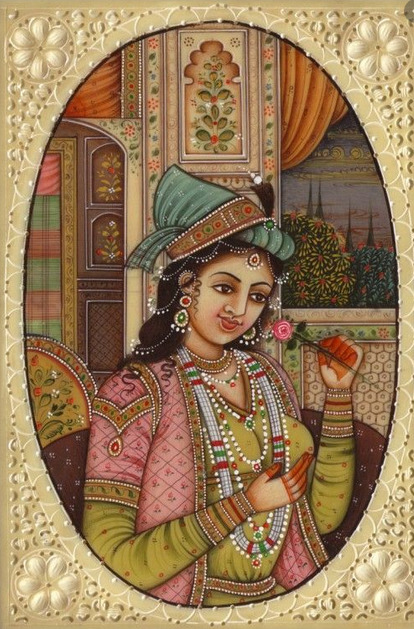
Ascension
Sultan Iltutmish had longed for his eldest Nasiruddin Mahmoud to be his successor, which unfortunately didn’t work out. He had died in 1229 mysteriously.
However, after Iltutmish's death, the nobles unanimously appointed his son Ruknuddin Firuz as his successor, who was Razia’s half-brother, and the son of Shah Turkan, Iltutmish’s lover. Proven to be an incapable and irrational ruler, this gave Razia a chance to prove herself. During a rebellion against Ruknuddin, Razia instigated the general public against Shah Turkan. He was deposed in 1236, six months after his rule. After the assassination of Ruknuddin and his mother, the throne was finally able to be taken by its rightful ruler.
Razia rose to the throne as Jalâlat ud-Dîn Raziyâ, after the assassination of her half-brother Ruknuddin and Iltutmish’s widow Shah Turkan after six months of his rule. Razia's ascension to the throne of Delhi was unique not only because she was a woman, but also because the support from the general public was the driving force behind her appointment.
Four Turkic nobles had joined with an army officer and decided to rebel against Razia’s ascension. As a result, she decided to seek help from the governor of Awadh, who was then captured by one Turkic nobles forced and killed in captivity. Razia then led an army out of the fortified city of Delhi to fight the rebels, and set up a camp on the banks of the Yamuna River. After a few skirmisher losses, tow of the rebel leaders joined Razia. They both had a discussion with her to capture the other rebel leaders. The other two Turkic nobles were arrested and executed. But the rebel officer escaped and hid in the Sirmaur Hills until his death.
Reign 1236-1240
She appeared in court without veil and in men’s attire. She had issued coins in her name.
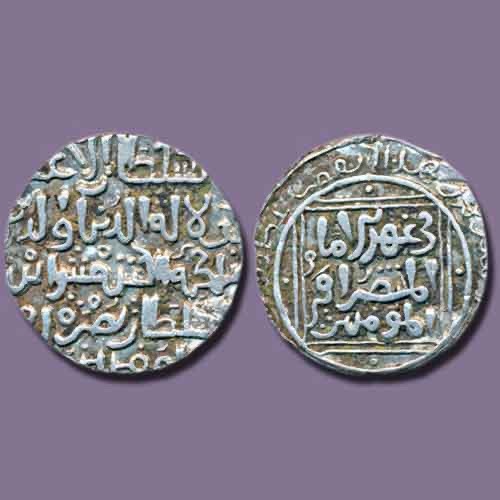

Throughout her reign, she faced lots of opposition from Turkic nobles in her court. Being aware of this, she appointed several non- Turkic nobles in high positions, which further created more opposition from her foes.
Razia appointed Malik Qutubuddin Hasan Ghuri to the newly created office of the army. Razia's first military campaign directed at non-rebels was an invasion of Ranthambore, whose Chahamana ruler had asserted his sovereignty after Iltutmish's death. Razia directed Ghuri to march to Ranthambore: he was able to evacuate the Turkic nobles and officers from the fort, but was unable to subjugate the Chahamanas. The Chahamanas, in alliance with the Mewatis, captured a large part of present-day north-eastern Rajasthan, and carried out guerilla war around Delhi. Razia also sent a force to re-assert Delhi's control over Gwalior, but this campaign had to be aborted.
The Shias had revolted against the Sultanate, but the rebellion was suppressed. One major incident occurred, when the Shia Qarmatians carried out an attack on the Jama masjid in Delhi. The Qarmatian leader Nuruddin Turk had earlier condemned the Sunni, Shafi‘i, and Hanafi doctrines, and had gathered nearly 1,000 supporters from Delhi, Gujarat, Sindh, and the Doab. On 5 March 1237, he and his supporters entered the mosque, and started killing the Sunnis assembled there for the Friday prayers, before being attacked by the citizens.
In 1238, Malik Hasan Qarlugh, the former Khwarazmian governor of Ghazni, faced a Mongol threat, and sent his son to Delhi, probably to seek a military alliance against the Mongols. Razia received the prince courteously, assigned him the revenues of Baran for his expenses, but refused to form an alliance against the Mongols.
Overthrow
The Turkic nobles wanted her to be a figurehead, but she asserted herself in her own power. By 1237–1238, she had started issuing coins solely in her own name. Razia appeared in front of her citizens in traditional male attire and rode elephants in the streets of Delhi like a typical Sultan.
In 1238–1239, Malik Izzuddin Kabir Khan Ayaz – the governor of Lahore – rebelled against Razia, and she marched against him, forcing him to flee to Sodhra. However, the area beyond Sodhra was controlled by the Mongols, yet Razia continued to pursue him. Izzuddin was forced to surrender and accept Razia's authority once again. Razia treated him leniently: she took away the iqta of Lahore from him, but assigned him the iqta of Multan, which Iltutmish had assigned to Ikhtiyaruddin Qaraqash Khan Aitigin.
Razia started showing favors to Ikhtiyaruddin Altunia, appointing him the iqta of Tabarhinda. However, him and another leader conspired to overthrow her, while she was away on her Lahore campaign. Once learning of this conspiracy, Razia marched towards Tabarhinda ten days later. The rebel forces imprisoned her.
Once news of her arrest reached Delhi, the Turkic nobles appointed Muizuddin Bahram, another son of Iltutmish. However, this Sultan was not the fairest. He had a former Ikhtiyaruddin Aitigin assassinated, who was supposed to handle affairs of the state. After hearing upon Razia’s return with her new husband, he led a rebel force against their’s. Altunia and Razia were forced to retreat to Kaithal.
Marriage and Relationships
She married, Ikhtiyaruddin Altunia in 1240, who was one of her enemies who sought to initially overthrow her in Tabarhinda. He and the rebel forces had her arrested.
The idea of the marriage came from the overthrow of Razia, after seeing disadvantages of the Delhi Sultanate, who failed to hold the kingdom together. Altunia lost all hope of realizing any benefits from Razia's overthrow, and decided to ally with Razia. Razia also saw this as an opportunity to win back the throne, and married Altunia in September 1240.
Razia also had a lover before her marriage, an Abyssinian slave named Yaqut.
She had no children in the marriage.
Death
Razia died in October 15, 1240 alongside her husband Altunia, after being deserted her soldiers, and from being assassinated by a group of Hindus.
Books
Jamila Brijbhushan, Sultan Raziya, Her Life and Times: A Reappraisal
Films and T.V. Shows
Kamal Amrohi’s Razia Sultana, 1983
Lead actress Hema Malini playing Razia Sultan.

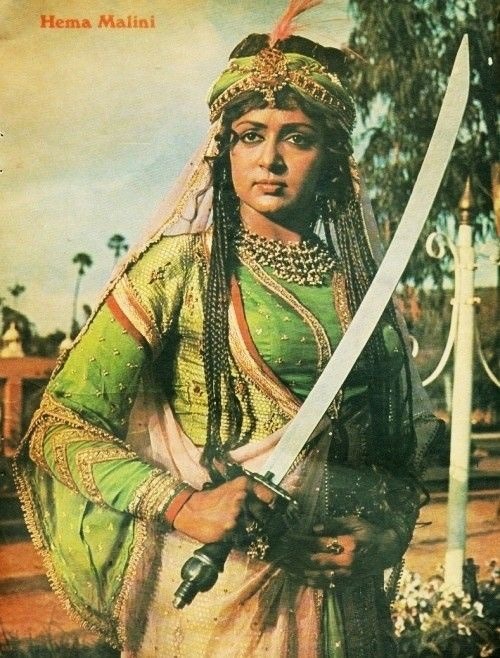
Zee T.V. Series, Razia Sultan, 2015
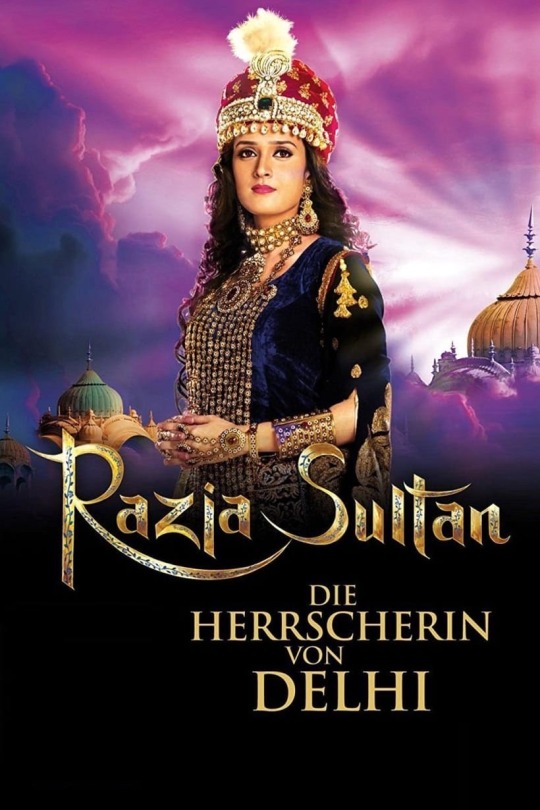
This poster is in German.
33 notes
·
View notes